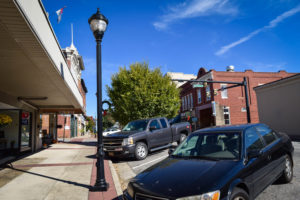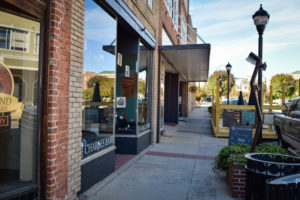By Jordan Stanley – 2016
The Expectation:
Lenoir was the last stop of a two-day, six-town road trip through the North Carolina Foothills. To get a taste of the town, one might start by driving down the main street, scavenging for hole-in-the-wall restaurants, and investigating a few mom-and-pop joints. One stop in particular, famous to Lenoir, is the Bolick Family Pottery Shop, well-known throughout the state for a unique yet traditional craft now transcending generations. Of course, a visit to Lenoir would not be complete without a dutiful visit to the famous Fort Defiance, a plantation house home to Revolutionary War General William Lenoir, the town’s namesake.
These stops, planned and unplanned, would serve a s a rich taste of North Carolina history and tradition. Yet the expectation of the town on a Sunday late afternoon–everyone would be leaving church, taking the dog for a walk, or going to lunch on their day off–was disrupted by a quite different reality.
s a rich taste of North Carolina history and tradition. Yet the expectation of the town on a Sunday late afternoon–everyone would be leaving church, taking the dog for a walk, or going to lunch on their day off–was disrupted by a quite different reality.
The Reality:
On a clear-skied, sunny day–characteristic of the summer season-turn-Fall–Lenoir welcomes incoming drivers with the “Welcome to Historic Lenoir” sign.
With a population of 18,000+, Lenoir is one of the more peopled towns of the Foothills, yet as the car tires roll into the downtown area, there was a sense of solitude, a feeling that may take moments to explain.
The Lenoir downtown consisted of a strip of quaint and traditional buildings marked by understated elegance–brick facades, and character. The eclectic exteriors of the buildings ran along a wide cement and brick sidewalk, ideal for families and friends walking side-by-side, heading to lunch or one of the several shops and cafes available.
Yet perhaps it was this exact feature, installed for community, that seemed to source of the feeling of loneliness, of incompleteness: these pedestrian-friendly sidewalks were empty, the parking spots absent of cars. Storefront after storefront was branded by a resigned “Sorry, We’re Closed” sign, above store hours that run Mon-Fri, maybe Saturday in some cases. Still, a quick drive-by cannot fully capture the liveliness of a town thrumming beneath. Getting out of the car–even if there only four or five others in sight–walking along main street, and taking a closer look is necessary before resigning to a quiet Sunday.
In addition the absence of Lenoir residents in the streets, the eerie feeling of the downtown was supplemented by a track of instrumental music playing thr oughout the street from a series of unseen speakers. The music could be described as a marriage of jazz piano and elevator music, perhaps meant to be a nice backdrop to the sounds of engines and human voices. The bizarre ambience, one reminiscent of a post-disillusioned movie, would still not be the main source of disappointment in Lenoir. The greatest disappointment offered by a quiet Sunday in this town, is that a walk along the main street revealed Lenoir has a lot to offer. Amongst a few cafes, the town’s GOP headquarters, and small markets, it seemed every other storefront was an art gallery or antique shop–both retailers for town character, personality, history, and secrets. In an eclectic collection of castaway personal belongings and artistic expression, these are the shops that give define Lenoir local flavor. The storefront windows were decorated with autumnal displays, from puppets, to art easels made of birch branches, to leaves and twigs perched with fake birds. Yet each was closed. Not a single site was open. Walks around square blocks, the real estate turning to banks and insurance fronts the farther the sidewalk talks you the center of town, and a feeling of defeat sinks into the sunny day.
oughout the street from a series of unseen speakers. The music could be described as a marriage of jazz piano and elevator music, perhaps meant to be a nice backdrop to the sounds of engines and human voices. The bizarre ambience, one reminiscent of a post-disillusioned movie, would still not be the main source of disappointment in Lenoir. The greatest disappointment offered by a quiet Sunday in this town, is that a walk along the main street revealed Lenoir has a lot to offer. Amongst a few cafes, the town’s GOP headquarters, and small markets, it seemed every other storefront was an art gallery or antique shop–both retailers for town character, personality, history, and secrets. In an eclectic collection of castaway personal belongings and artistic expression, these are the shops that give define Lenoir local flavor. The storefront windows were decorated with autumnal displays, from puppets, to art easels made of birch branches, to leaves and twigs perched with fake birds. Yet each was closed. Not a single site was open. Walks around square blocks, the real estate turning to banks and insurance fronts the farther the sidewalk talks you the center of town, and a feeling of defeat sinks into the sunny day.
The Change of Plans:
Ultimately, hunger and defeat merge to form resignation–forcing a return to the one restaurant open, initially passed by due to lack of interest. It was a small bistro called Bella Torte Bistro, dawned with trendy iron outdoor dining furniture, and an updated, French-decorated interior. It was clear, that flannels, t-shirt, and leggings meant being underdressed, but an empty stomach and low self-consciousness of a foreign place equate to going in anyway. Passing beneath the turquoise Bella Torte Bistro sign, sticking from the corner of the building, a hostess/waitress opened the door with a warm welcome.
The inside was modern with wood floors, shapely chairs and multiple levels of seating. Each table was punctuated by pots of turquoise blue, silver, and white flowers in the color scheme of the restaurant and sign outside. An iron staircase winds up to a third-floor landing with extra seating, as well as downstairs to the basement where  one finds Charlie’s Pub. It seemed the Pub shared the same menu as the Bistro, but with a different wood-panel and booth atmosphere. A table at the back of the restaurant sat regally, occupied by a family of 10+ dressed up in what looked to be church gear as a long table. Off to the side sat a priest and two elderly women, dressed to the nines, sharing lunch and forkfuls of pie.
one finds Charlie’s Pub. It seemed the Pub shared the same menu as the Bistro, but with a different wood-panel and booth atmosphere. A table at the back of the restaurant sat regally, occupied by a family of 10+ dressed up in what looked to be church gear as a long table. Off to the side sat a priest and two elderly women, dressed to the nines, sharing lunch and forkfuls of pie.
For Foothills-French cuisine, the food was wonderful, ranging from reimagined Ceasar salad, to three-cheese mac-n-cheese, to classic French onion soup and traditionally delicious French fries. Despite a satisfying meal, it was difficult to determine what inquiry was left in Lenoir–that is, beyond where is everybody? Was there an opportunity being missed here–that a schedule only allowing Saturday and Sunday travel would deprive towns like Lenoir of the opportunity to showcase their identities?
On the way out, the hostess/waitress rang up each receipt by the coffee pot and pastries and spoke about the bistro. The only reason it was open on a Sunday–of all the other real estate on the main strip–was because it was new to Lenoir and wanted to establish a following. She felt their opening is a small part of the town’s effort to revitalize the downtown, which had been a town goal for the past and upcoming years, potentially creating a college town experience for the local university. She said that town wasn’t empty due to church and post-church Sunday traditions; rather Sundays and Mondays were just Lenoir’s slow da ys– business always picked up on Tuesday and more so throughout the week. Her comments were simple and decided, prompting the questions: Was her acceptan ce of the slow Sunday business a sign of how things have always been–and was it actually related to Sunday culture of North Carolina? Was this empty downtown just how things had been for so long that people have forgotten why? Are these questions worth asking?
Suffice to say, the little luck in Lenoir painted a picture of North Carolina Foothills Sunday culture: laid back, not commercial, and perhaps not even capitalistic. Things shut down, the businesses, the food, the roads even. Ultimately, he deeper reasoning behind this scene could not be determined from an outsider–trying to work on the locals’ day of rest.
